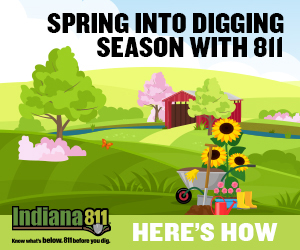Add Tropical Splendor to Your Indiana Landscape

Photo credit: iStock/Supersmario
If a trip to the tropics isn’t on the itinerary this year, how about bringing the tropics to your summer landscape?
You might already have a few of the more common tropical plants, such as potted hibiscus or gardenia.
But for many gardeners, the tropics are best represented by what’s known as elephant ears. Add to that the giant leaves of banana trees and you’re not in Indiana anymore.
The Giants of the Tropics

Photo credit: Irvin Etienne
Commonly called elephant ears, alocasia and colocasia look similar, but differences exist.
Alocasia leaves tend to be upward or outward facing. Most alocasias do best in shade to partial sun, although those with green leaves tolerate more sun. They are clump growers. Too much water or poor drainage may cause these plants to rot.
Colocasia leaves tend to be downward facing. These can take full sun and tolerate moist or wet soil. Colocasia is frequently used as a water plant. It grows by runners, which means when grown in a pot, the soil will be filled with roots by the end of summer.
Growing elephant ears in pots or other containers controls the size of the plant, says Irvin Etienne, curator of herbaceous plants and seasonal garden design at Newfields, formerly the Indianapolis Museum of Art. The larger the pot, the larger the plant will be. According to label directions, alocasia and colocasia grown in pots will be happier and look healthier if fertilized regularly.
Elephant ears also can be planted in the ground, where they should do well with decent soil, eliminating the need for fertilizer, Etienne says. He has dozens of tropical plants on his 7 acres in rural Rush County. He also had an extensive collection of tropical plants at his home in Fountain Square, an urban neighborhood in Indianapolis, the site of many garden tours.
If planted in a pot, once the leaves have been hit by frost, drag the container indoors and use it as a houseplant. Or take it to an area, such as a basement, where the plant will go dormant. Cut back foliage if the plant is to go dormant. Etienne says alocasia is a better choice as a winter houseplant because upward-facing leaves require less space. Alocasia’s lower light requirement also makes it a better houseplant.
If the alocasia or colocasia spent the summer in the ground, allow frost to hit the leaves in fall. Cut off the leaves, dig the plant and store in a place where it won’t freeze or get too warm. Replant when the weather allows in late spring.
“Or you can just let them die. It’s OK,” says Etienne, who speaks all over the country about tropical plants.
See more: Easy Peasy Summer Annuals For the Garden
Going Wild for Bananas

Photo credit: Jo Ellen Meyers Sharp
The other plant that screams tropics is the banana. There are two types on the market. Musa is a true banana. Ensete is a banana relative, and it usually has wider leaves than a true banana. There’s also a red-leaf variety. Ensete does not have side shoots, but Musa does.
For winter, allow the leaves to be hit by frost, then cut them back to 3 feet. Dig the plant to bring to the basement or other place not too cold or too hot to go dormant.
Musa basjoo (pronounced baa sue) is winter hardy throughout much of Indiana with just a little care. Bananas may form during the summer, but usually the season isn’t long enough for them to ripen. True banana plants send up what’s called pups or side shoots.
Once the leaves have been hit by frost, Etienne recommends removing them. “They are a lot harder to cut off in spring,” he says. Cut the plant stalk back to about 3 feet and cover with mulch. Remove mulch once the weather warms up enough to encourage new growth.
Alocasia, colocasia and the two banana plants are readily available at garden centers in spring and early summer. Houseplant stores may carry some of these plants year round. Even Ikea has a houseplant section, as do many grocery stores. However, online retailers, especially those specializing in bulbs, may be your best bet for the greatest choice of varieties.
About the Author: Jo Ellen Meyers Sharp blogs at hoosiergardener.com. She’s a popular speaker with more than 50 five-star reviews at greatgardenspeakers.org.










 My Indiana Home is produced for Indiana Farm Bureau members. Our mission is to connect you with the food you eat, the Indiana farmers who grow it and a rural lifestyle that is uniquely Hoosier.
My Indiana Home is produced for Indiana Farm Bureau members. Our mission is to connect you with the food you eat, the Indiana farmers who grow it and a rural lifestyle that is uniquely Hoosier.
Leave a Comment